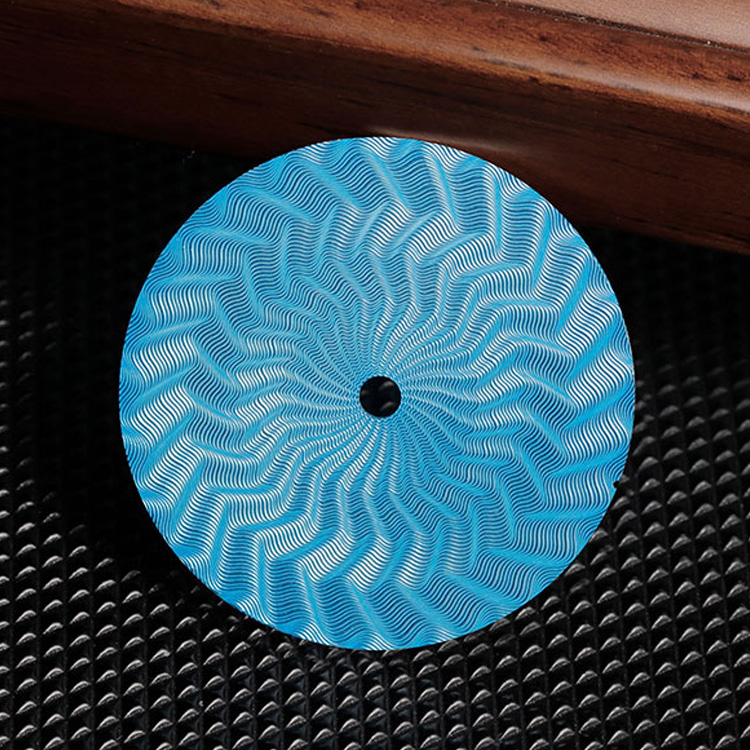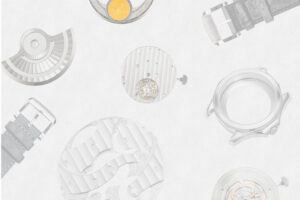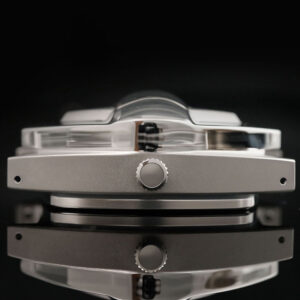Origins and Historical Significance of Guilloché
The Birth of Guilloché in Horology
The art of guilloché—or engine turning—has been linked to fine watchmaking for over two centuries. Although geometric engraving existed earlier, its use in horology is widely credited to Abraham-Louis Breguet. Because he understood how engraved patterns reduced glare and therefore improved readability, the guilloché dial became both a functional and aesthetic breakthrough. Since then, this technique has remained a signature element that defines craftsmanship and brand identity.
Development of Engine-Turning Machines
The craft evolved as specialized machines were invented to carve precise geometric patterns into metal surfaces. Two engines became essential tools:
-
The Rose Engine, capable of producing complex curves, waveforms, and floral motifs.
-
The Straight-Line Engine, ideal for linear, basket-weave, and rectangular patterns.
These machines required mastery, precision, and a steady rhythm—conditions that remain unchanged today.
The Lost Art and Its Revival
With the rise of industrialization and mass manufacturing, traditional engine turning became increasingly rare. Many brands shifted to stamped or machined textures, leaving only a handful of artisans to carry the tradition forward. Today, a resurgence of appreciation for authentic craftsmanship has revived interest in hand-guilloché, transforming it into a mark of distinction among high-end and independent brands.

Technical Mastery Behind a Guilloché Dial
Engine Turning Techniques: Rose and Linear Engines
Creating a guilloché dial is a process of controlled imperfection—each line is manually cut, one by one, using a centuries-old mechanical engine. The artisan guides the workpiece against a fixed cutting tool, adjusting pressure and rotation to bring patterns to life. The machine never works alone; it is a partnership between human intuition and mechanical precision.
Precision, Pressure, and Pattern Geometry
A true guilloché dial is defined by micro-engraved grooves, each reflecting light differently. Every pass of the blade must be executed with equal force and consistent depth. Any deviation is visible. This delicate synergy between geometry, texture, and light gives guilloché its unmistakable brilliance and tactile quality.
Materials and Surface Preparation
Most guilloché dials begin with soft metals such as sterling silver, brass, or gold. These materials accept microscopic engraving without cracking. The surface is carefully smoothed, annealed if necessary, and mounted on the engine before carving begins. Some brands then apply enamel over the engraved pattern to create the highly sought-after guilloché enamel finish. Watcheshome guilloche
Guilloché Patterns as Brand Signatures
Signature Motifs and Their Meanings
Brands adopt unique guilloché motifs to reinforce their visual identity. Examples include:
-
Clous de Paris (hobnail pattern): found in classical Swiss designs.
-
Sunburst and Radiant Motifs: communicating energy and motion.
-
Ricochet Pattern: famously used by independent watchmakers to create concentric ripples on the dial.
These patterns function like a fingerprint—instantly recognizable and deeply symbolic.
Visual Hierarchy Through Pattern Variations
Guilloché can organize a dial’s layout by assigning different patterns to different zones. Subdials might use barleycorn engraving to contrast with a basket-weave central section. Minute tracks may employ linear patterns to guide the eye. This multi-texture approach enhances readability while adding depth and refinement.
Pattern as a Storytelling Element
Every engraving tells a story. The rhythm of the cuts, the way light dances across the dial, and the subtle imperfections left by the artisan combine to express the brand’s philosophy—whether classical elegance, avant-garde creativity, or high-end mechanical purity.

Modern Guilloché: Innovation Meets Tradition
Hand-Guilloché vs Stamped / CNC Guilloché
Modern watchmaking offers more techniques to achieve guilloché-like textures:
-
Stamped textures mimic patterns through pressure-formed metal.
-
CNC machining cuts patterns programmatically with modern tools.
However, only true hand-guilloché—engraved with traditional engines—creates the optical depth and organic irregularities collectors prize. This distinction has become a clear differentiator in brand storytelling and pricing.
Guilloché in Contemporary and Independent Brands
Independent watchmakers and niche brands have embraced guilloché as a core artistic expression. Their approaches vary from classic patterns to modern reinterpretations that blend geometry with contemporary aesthetics. Many still rely on century-old engines, believing that craftsmanship defines authenticity.
Enamel + Guilloché: The Basse-Taille Technique
Guilloché enamel dials are among the most coveted in watchmaking. After engraving the metal, layers of translucent enamel are applied and repeatedly fired at high temperatures. Light penetrates the enamel and reflects off the engraved metal beneath, creating a luminous, almost three-dimensional appearance. This fusion of engraving and enamel is a hallmark of high luxury.
Craftsmanship, Quality & Market Value
Rarity and Artisanal Value
Very few artisans in the world can execute traditional guilloché at a high level. Their training takes years, and the work demands unwavering concentration. As a result, hand-guilloché dials carry inherent rarity and value, often reserved for limited or bespoke collections.
Brand Differentiation Through Dial Finishing
Dial finishing is one of the clearest expressions of brand identity. Guilloché allows a brand to communicate heritage, artistry, and mechanical integrity—all through texture. When a brand invests in traditional techniques, it demonstrates a commitment to authenticity rather than mass production.
Authenticity and Collector Appeal
Collectors increasingly seek transparency: Is the guilloché real or stamped? Is it done by hand or CNC? Brands that showcase their process earn greater trust, loyalty, and long-term brand equity.
Strategic Implications for Brand Identity
Storytelling and Heritage Marketing
In a competitive market, guilloché offers more than decoration—it provides a narrative. The history, craftsmanship, and handmade details become part of the brand’s DNA, helping consumers emotionally connect with the product.
Innovation as Brand Promise
Brands that blend traditional guilloché with modern materials or advanced engineering reinforce an image of innovation rooted in heritage. This balance is key to contemporary luxury positioning.
Long-Term Brand Equity
Consistently using authentic guilloché builds recognition and prestige over time. For many brands, it becomes a signature that sets them apart—just as iconic case shapes or movement architecture do. Watcheshome manufactory
Conclusion
Guilloché Dial as a Timeless Signature
Guilloché is more than a surface treatment; it is an emblem of craftsmanship, heritage, and precision. Its enduring beauty lies in the interplay of light, geometry, and hand-guided artistry. For brands, it serves as a powerful tool to strengthen identity and distinguish their watches in a crowded marketplace.
The Future of Guilloché in Watchmaking
As collectors increasingly value authenticity and craftsmanship, guilloché is poised to remain a defining feature of high-end horology. Whether applied traditionally or combined with modern innovations, it embodies the timeless union of art and engineering.







